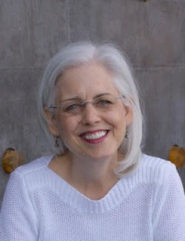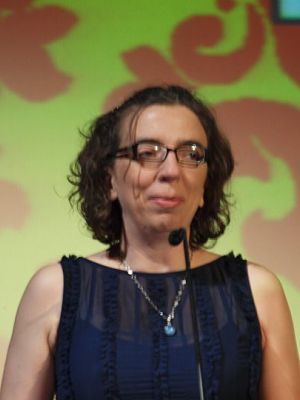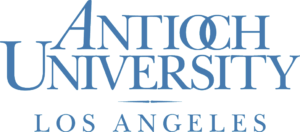Susan Southard, Author
 During the June 2016 residency of Antioch’s MFA program, Susan Southard taught a workshop on research-based writing, having written Nagasaki, a heavily researched and beautiful work of nonfiction about life after nuclear war. She explained that while John Hersey had written about the bombing of Hiroshima, no one had written about Nagasaki. Her workshop turned into a conversation about the process of writing Nagasaki, which took twelve years to complete and tells a story that has never been told, and how writing it was an act of social justice. Everyone left with the indelible impression that Southard had given a great gift to all of us with this project.
During the June 2016 residency of Antioch’s MFA program, Susan Southard taught a workshop on research-based writing, having written Nagasaki, a heavily researched and beautiful work of nonfiction about life after nuclear war. She explained that while John Hersey had written about the bombing of Hiroshima, no one had written about Nagasaki. Her workshop turned into a conversation about the process of writing Nagasaki, which took twelve years to complete and tells a story that has never been told, and how writing it was an act of social justice. Everyone left with the indelible impression that Southard had given a great gift to all of us with this project.
Nagasaki is the story of five hibakusha, survivors of the nuclear bombing of Nagasaki. Each of the hibakusha was a teenager at the time of the bombing, each lost family and close friends, and each has a different story of recovery and survival. It’s a braided narrative that begins with a description of the political situation and state of the war, continues with a vivid and detailed account of the bombing, and gradually follows the lives of the hibakusha for decades afterwards.
Southard is an intentional writer. She chooses every word carefully. She is committed, beyond the average expectation, to being true to the stories she tells. She understands the power of storytelling and uses an astounding amount of research to ensure that she does the story justice. Writing Nagasaki involved multiple trips to Japan, a Japanese translator, and years of research assistance. The resulting work allows us as readers and citizens to understand so much more about the consequences of nuclear war than we did before.
During the time I was exchanging emails with Susan for this interview, she was invited to speak at the United Nations, and won the Dayton Literary Peace Prize, the only international peace prize awarded in the U.S. This well-deserved recognition was not only for her writing, but also for her contribution to history, society, and citizenship.
The rest of Southard’s life reflects the same intensity of commitment. She has taught writing in prisons to youth and to women. She is the founder and Artistic Director of the Essential Theatre, a playback theatre company. She describes playback theatre as “an interactive, improvisational performance in which members of the audience tell stories from their lives and then watch the performing ensemble of actors and musicians bring the story to artistic life.”
Southard brings real people’s stories of survival to life, in all of their complicated, beautiful, messy wonder.
Emma Margraf: You founded a professional theater and social change company that focuses on Playback Theatre, an effective tool in mixing art and social justice; you are a graduate of the Antioch MFA program, which has a social justice emphasis; and you wrote Nagasaki: Life After Nuclear War, which gives readers a profound understanding of the impact of nuclear bombs on humanity. Why is social justice important to you?
Susan Southard: Most of my life, I have been drawn to the stories of individuals who have felt invisible, whose realities and suffering have been minimized or denied. Being a part of making visible what has been hidden is important to me, and I think it permeates both my theatre and writing work. It’s also very important to me as a person and as a U.S. citizen that I—and my country—am accountable, as much as possible, for the impact of my actions on others. This is not a strong suit for the United States.
EM: Do you consider yourself an author or an artist first? How do the two interact?
It’s also very important to me as a person and as a U.S. citizen that I—and my country—am accountable, as much as possible, for the impact of my actions on others. This is not a strong suit for the United States.
SS: What an intriguing question! At the moment, I’m not sure. In the past, I would have definitely considered myself a theatre artist first—it’s something I’ve done for nearly thirty years. Two years ago, in order to finish my book, I stopped acting and directing in my company, so now I feel less of a theatre artist than before. And since being a published author is still fairly new to me, that label still feels a bit foreign.
The thread that binds Playback Theatre and narrative journalism is storytelling. Though the process and end results are completely different, both art forms require listening to and witnessing a person’s experience and then sculpting an artistic work to honor the story. In the case of Playback Theatre, someone in the audience tells a true story from her life, and the ensemble of actors and musicians bring the story to artistic life through movement, music, metaphor, and scenes. It’s improvised and immediate, in front of person who told the story and the audience.
Writing Nagasaki, on the other hand, took twelve years, and except for my trips to Nagasaki to interview survivors, physicians, and atomic bomb specialists, most of the work took place in my office, not in a rehearsal hall or performance space. Sometimes I worked with my researcher or with the team of translators I hired to help me with the interviews, essays, articles, and letters needed to complete my research. Mostly, though, I worked alone, which was so different from the collaborative ensemble process of Playback Theatre.
EM: Nagasaki is powerfully and thoroughly researched, which the reader experiences right from the start of the book. What drove you to that level of research? Why was it important to you?
Two things kept me going: First, I had really come to love the survivors whose stories I was telling, and second, I felt it was so important to bring their stories, still hidden from view in our country, into visibility.
SS: When I started the project in 2003, I had no idea how much research would be required. As I interviewed the survivors, conducted some initial research, and began trying to formulate a narrative, it was clear that the story was far bigger than I had thought, and that in order to tell the personal and community stories of post-nuclear survival with accuracy and breadth, I had to research, understand, and interpret for my readers many topics I previously knew nothing about—for example, the effects of high-dose radiation exposure on the human body, U.S. censorship and denial of these effects, the U.S. occupation of Japan, the job and marriage discrimination hibakusha experienced because of their potential long-term health risks, and on and on. Finding and analyzing sources and conducting this level of research was something I’d never done, so I hired an amazing researcher, Robin LaVoie, who worked full-time with me on the project for many years. The book would not exist in its present form without her.
EM: This project spanned twelve years, as you’ve noted. How did your vision shift over time?
SS: It’s very interesting to look back now, with a bit of perspective. My initial vision—to tell the survivors’ stories—was passionate and committed, but also simple and naïve; as I said before, I had no idea what I was getting myself into. The first big shift in my vision came about a year in, when I realized the scope of the story I was telling and worked to adapt my thinking and planning to hold this new view. The second major shift came after I submitted the first four chapters (about half the manuscript) to my editor. I didn’t realize how tentative my authorial voice was; I was afraid to get things wrong, so I never took full grasp of the narrative. In my editor’s feedback to me, he challenged me to take hold of the narrative with authority. It took me a long time to understand how to do this, but his mandate, and my efforts to fulfill it, transformed not only my vision for the book but the actual words on every page.
EM: The narrator’s voice is consistent throughout the telling the stories of five very different people. How did you decide whether to keep yourself out of the story?
SS: At first, I was in the story. Not a lot, but whenever survivors were recounting specific memories, I included my asking the questions to them, and I described what the survivors looked like, their facial expressions and gestures, and their surroundings, etc. I wanted the reader to feel like they were in the same room with the survivors, experiencing them as I had. But my editor, and also Viking’s senior nonfiction editor, strongly advised me to take myself out. It took a while to fully accept their suggestion, but ultimately I completely agreed—especially after I began strengthening my authorial voice.
EM: I found myself needing to take breaks from reading Nagasaki, as it so thoroughly threw me into the hard world of the hibakusha. How did their stories affect you personally?
SS: It was a huge honor to hold their stories and strive to bring them to life in my book. At the same time, it was often extremely hard. The horrors of the bomb and the extreme suffering at so many different levels, of those who died and those survived, were overwhelming. Sometimes it was overwhelming and, like you, I had to take breaks too. Two things kept me going: First, I had really come to love the survivors whose stories I was telling; and second, I felt it was so important to bring their stories, still hidden from view in our country, into visibility.
EM: Propaganda plays a big role in this story, as does perspective. You’ve said that you get angry responses from American readers who believe Nagasaki is too slanted towards the Japanese. Were you aware when you started this of how strongly some feel about this?
I believe it’s critical that we look at history through the clearest lens possible, and that if we choose to take and defend wartime military actions that cause great harm to civilians, we must also be willing to look at the impact of those actions…
SS: Not at the beginning, but it didn’t take long. Long threads of hate-filled comments fill some veterans’ online chatrooms, which gave me a clear idea of the vitriol many people still feel and openly express about the Japanese people during World War II. I have received passionate, angry emails and letters asking me if I had been to Pearl Harbor, or saying that the writer, or his father, was saved by the atomic bombings because he didn’t have to participate in the planned land invasion of Japan. One thing I often say at readings and book talks is that Nagasaki in no way defends the Japanese military’s attack on Pearl Harbor, atrocities in China, or mistreatment, torture, and killing of Allied POWs.
At the same time, I believe it’s critical that we look at history through the clearest lens possible, and that if we choose to take and defend wartime military actions that cause great harm to civilians, we must also be willing to look at the impact of those actions, regardless of our perceptions or feelings about how the war ended.
It’s important to say, too, that I have received far more positive communications from readers than negative, from people who lived through World War II and those who are just coming of age now and learning about the atomic bombings.
EM: Do you think there are lessons from Nagasaki relevant to today’s politics?
SS: Yes, I think there are many connections to today’s politics. First, there are so many ways that our politicians (and we, everyday citizens) justify our actions—like the atomic bombings of Nagasaki and Hiroshima—that cause great harm to others, and our justifications somehow gives us permission turn away from seeing the consequences of our actions. Second (and connected to the first), which stories we tell, and how we tell them, matters not only to history but also to our integrity as individuals and as a nation. Is there room for all of the stories, even those that we don’t want to hear? Third, Nagasaki holds the profound and difficult lesson of the humanitarian impact of nuclear war and the twisted perspective that nuclear weapons are instruments of peace.
EM: Much of Nagasaki reads like textbook coverage of the event with an added element of riveting narrative. Were you interested in developing this educational aspect when you started the project? How would you like to see Nagasaki taught in schools?
SS: I didn’t write Nagasaki from an educational perspective, but I do hope that it will be taught in both high schools and colleges, as John Hersey’s Hiroshima (1946) is. While [the city of] Hiroshima takes the focus of nearly all atomic bomb discussions in schools, Nagasaki is barely an afterthought in most people’s minds. But the atomic bombing of Nagasaki was a separate act of warfare, under different circumstances, using a different kind of bomb on a city with a different history and culture than Hiroshima. I hope my book helps make Nagasaki and its hibakusha an integral part of how we remember, analyze, and understand the 1945 atomic bombings of Japan.
EM: It seems clear that you have a strong commitment to authenticity, particularly when it comes to telling stories of the invisible. Why is true detail so important? Is a commitment to authenticity especially important when telling the stories of the invisible?
SS: True details are absolutely critical in telling anyone’s story, perhaps most especially those of people who have been invisible. Because if we as writers are going to give them a voice, it has to be their voice, their experience. Otherwise, we are—even if unintentionally—appropriating their stories for our own use and again yielding power that silences their individual voices, experiences, and truths.
EM: What advice do you have to other authors interested in research based writing?
[Taniguchi Sumiteru] and many other Nagasaki survivors have spent much of their lives trying to ensure that Nagasaki remains the last atomic-bombed city in history.
SS: Here are some things I learned that might be helpful: If you know how to find excellent sources, great; if not, get help from a skilled researcher. Work hard to understand your own bias and the biases of authors whose work you are using in your research. This will inform you invaluably. For me, at least, it was a long and arduous, but also amazing and life-changing process. Finally, choose a story or topic that nourishes you on many levels, and if it really matters to you, don’t give up!
EM: What role do you think artistic freedom plays in research-based historical nonfiction?
SS: This was a question I grappled with during the research and writing of Nagasaki. Where is the line between fact and artistic freedom? “Artistic freedom” may be more restrained for nonfiction writers, and I certainly gave highest priority to factual truth that I could back up by my research. But nonfiction writers have a lot of freedom, too—and responsibility, I think—to bring the facts alive with language, structure, characters, and scenes: to engage the reader from one page to the next.
EM: You have taught writing in prisons to both women and young people. Could you tell me more about that?
SS: Yes, I briefly taught personal narrative writing for juveniles (boys) in a state prison. There, I mostly introduced writing prompts and freewriting exercises to give the boys a sense of inner freedom, and to explore new and different ways to mine and express their memories. Also, I directed a three-year creative writing program for women at a federal prison outside Phoenix. In this program we also used writing prompts to explore memory and personal narrative. But we took the artistic process much further by creating longer, polished pieces. At the end of each workshop series, the women read their deep, moving, and often funny work for an audience of enthusiastic and receptive peers. This program was labor-intensive, as I provided editing to each piece every week so the writers could revise and strengthen their writing, but it was the most fulfilling and transformative teaching project I’ve ever done. The women were hungry to learn, ready to take feedback, and thrilled as they saw their writing transform into beautiful work. The program ended due to funding issues; I wish it were still going!
EM: What do you think are the connections between writing and advocacy? What can writers learn from that kind of work?
SS: I don’t think of myself as an advocate of or for something/someone…more, I’m a witness? A sculptor of stories? As I think more about your question, I’d say that my activism is more subversive than public. That is, typically I don’t speak out about issues that are important to me; I tell the stories that I hope will impact others to think more deeply, expansively, and empathetically. This is what I love to do. And, as a result of the opportunity to be published here and in other countries, I’m grateful that people in the United States and different parts of the world are now reading the survivors’ personal experiences and understanding more fully the enduring impact of nuclear war.
EM: You just spoke at the United Nations, an incredible honor. Can you tell me a little bit about what brought you there and how it went?
SS: Because of my book, I was invited to represent the International Campaign Against Nuclear Weapons (ICAN), a coalition of 440 partner organizations in ninety-eight countries, to speak at the United Nations International Day for the Total Elimination of Nuclear Weapons. It was a high-level meeting of representatives from many U.N. nation-states designed to promote and move forward the U.N.’s goal to eliminate nuclear weapons throughout the world.
One of the fascinating parts of the day was listening to forty-four delegates speak about their country’s position on nuclear weapons, and to understand the nuances of their language. Depending on how they worded their statements, they subtly indicated their acceptance of the status quo or their commitment to negotiate and sign a nuclear weapons ban treaty. The delegate from Russia spoke defensively about its nuclear security needs, and when the representative from North Korea spoke, the whole room went silent. The man spoke defiantly of his country’s need to develop and expand its nuclear weapons program in the face of constant nuclear threats by the United States since the early 1950s. The United States didn’t even come, which was expected, but—for me, at least—disheartening.
I was one of the last speakers of the day, and I had ten minutes compared to the four minutes each delegate had—not sure how that happened! I spoke about how important it is to achieve the proposed nuclear ban treaty, and why. I spoke about the Nagasaki and Hiroshima bombings, bringing to life some of the visceral terrors of those days and the weeks, months, and years that followed. I was able to weave in the story of Taniguchi Sumiteru, one of the five survivors whose story I tell in my book, briefly telling what happened to him, and speaking to his anger when he hears nuclear-armed nations argue that nuclear weapons exist as a deterrent to war. He and many other Nagasaki survivors have spent much of their lives trying to ensure that Nagasaki remains the last atomic-bombed city in history.
I was extremely nervous but fortunately well-practiced, so I was able to speak with energy and confidence, and it was very moving to me to speak about the Nagasaki hibakusha and the need for total nuclear disarmament to this audience. Afterward, a Japanese man who works in the U.N. Office of Disarmament Affairs told me that this was the first time Nagasaki had ever been included in such an address; the Japanese atomic bomb narrative always focuses on Hiroshima. How glad I am about this—and I’m extremely grateful to have had this opportunity—is more than I can say.





